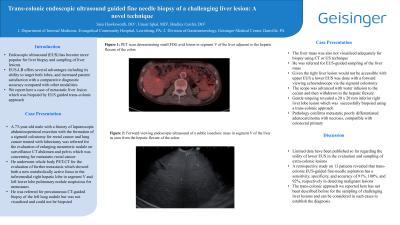Back

Poster Session A - Sunday Afternoon
Category: Interventional Endoscopy
A0443 - Trans-colonic Endoscopic Ultrasound-Guided Fine Needle Aspiration Biopsy of a Challenging Liver Lesion: A Novel Technique
Sunday, October 23, 2022
5:00 PM – 7:00 PM ET
Location: Crown Ballroom


Sara J. Hawksworth, DO
Evangelical Community Hospital
Lewisburg, Pennsylvania
Presenting Author(s)
Sara J. Hawksworth, DO1, Umair Iqbal, MD2, Bradley D. Confer, DO2
1Evangelical Community Hospital, Lewisburg, PA; 2Geisinger Medical Center, Danville, PA
Introduction: Endoscopic ultrasound (EUS) has become more popular for liver biopsy and sampling of liver lesions. EUS-LB offers several advantages including its ability to target both lobes, and increased patient satisfaction with a comparative diagnostic accuracy compared with other modalities. We report here a case of metastatic liver lesion which was biopsied by EUS guided trans-colonic approach.
Case Description/Methods: A 73-year-old male with a history of laparoscopic abdominoperineal resection with the formation of a sigmoid colostomy for rectal cancer and lung cancer treated with lobectomy was referred for the evaluation of enlarging mesenteric nodule on surveillance CT abdomen and pelvis which was concerning for metastatic rectal cancer. He underwent whole body PET-CT for the evaluation of further metastasis which showed both a new metabolically active focus in the inferomedial right hepatic lobe in segment V and left lower lobe pulmonary nodule suspicious for metastases. He was referred for percutaneous CT-guided biopsy of the left lung nodule but was not visualized and could not be biopsied. The liver mass was also not visualized adequately for biopsy using CT or US technique He was referred for EUS-guided sampling of the liver mass. Given the right liver lesion would not be accessible with upper EUS, a lower EUS was done with a forward viewing echoendoscope via the sigmoid colostomy. The scope was advanced with water infusion to the cecum and then withdrawn to the hepatic flexure. Gentle torquing revealed a 20 x 20 mm inferior right liver lobe lesion which was successfully biopsied using a trans-colonic approach. Pathology confirms metastatic poorly differentiated adenocarcinoma with necrosis, compatible with colorectal primary.
Discussion: Limited data have been published so far regarding the utility of lower EUS in the evaluation and sampling of extra-colonic lesions. A retrospective study on 13 patients revealed that trans-colonic EUS-guided fine-needle aspiration has a sensitivity, specificity, and accuracy of 91%, 100%, and 92%, respectively in detecting malignant lesions. The trans-colonic approach utilizing forward viewing echoendoscope we reported here has not been described before for the sampling of challenging liver lesions and can be considered in such cases to establish the diagnosis.
Disclosures:
Sara J. Hawksworth, DO1, Umair Iqbal, MD2, Bradley D. Confer, DO2. A0443 - Trans-colonic Endoscopic Ultrasound-Guided Fine Needle Aspiration Biopsy of a Challenging Liver Lesion: A Novel Technique, ACG 2022 Annual Scientific Meeting Abstracts. Charlotte, NC: American College of Gastroenterology.
1Evangelical Community Hospital, Lewisburg, PA; 2Geisinger Medical Center, Danville, PA
Introduction: Endoscopic ultrasound (EUS) has become more popular for liver biopsy and sampling of liver lesions. EUS-LB offers several advantages including its ability to target both lobes, and increased patient satisfaction with a comparative diagnostic accuracy compared with other modalities. We report here a case of metastatic liver lesion which was biopsied by EUS guided trans-colonic approach.
Case Description/Methods: A 73-year-old male with a history of laparoscopic abdominoperineal resection with the formation of a sigmoid colostomy for rectal cancer and lung cancer treated with lobectomy was referred for the evaluation of enlarging mesenteric nodule on surveillance CT abdomen and pelvis which was concerning for metastatic rectal cancer. He underwent whole body PET-CT for the evaluation of further metastasis which showed both a new metabolically active focus in the inferomedial right hepatic lobe in segment V and left lower lobe pulmonary nodule suspicious for metastases. He was referred for percutaneous CT-guided biopsy of the left lung nodule but was not visualized and could not be biopsied. The liver mass was also not visualized adequately for biopsy using CT or US technique He was referred for EUS-guided sampling of the liver mass. Given the right liver lesion would not be accessible with upper EUS, a lower EUS was done with a forward viewing echoendoscope via the sigmoid colostomy. The scope was advanced with water infusion to the cecum and then withdrawn to the hepatic flexure. Gentle torquing revealed a 20 x 20 mm inferior right liver lobe lesion which was successfully biopsied using a trans-colonic approach. Pathology confirms metastatic poorly differentiated adenocarcinoma with necrosis, compatible with colorectal primary.
Discussion: Limited data have been published so far regarding the utility of lower EUS in the evaluation and sampling of extra-colonic lesions. A retrospective study on 13 patients revealed that trans-colonic EUS-guided fine-needle aspiration has a sensitivity, specificity, and accuracy of 91%, 100%, and 92%, respectively in detecting malignant lesions. The trans-colonic approach utilizing forward viewing echoendoscope we reported here has not been described before for the sampling of challenging liver lesions and can be considered in such cases to establish the diagnosis.
Disclosures:
Sara Hawksworth indicated no relevant financial relationships.
Umair Iqbal indicated no relevant financial relationships.
Bradley Confer indicated no relevant financial relationships.
Sara J. Hawksworth, DO1, Umair Iqbal, MD2, Bradley D. Confer, DO2. A0443 - Trans-colonic Endoscopic Ultrasound-Guided Fine Needle Aspiration Biopsy of a Challenging Liver Lesion: A Novel Technique, ACG 2022 Annual Scientific Meeting Abstracts. Charlotte, NC: American College of Gastroenterology.
